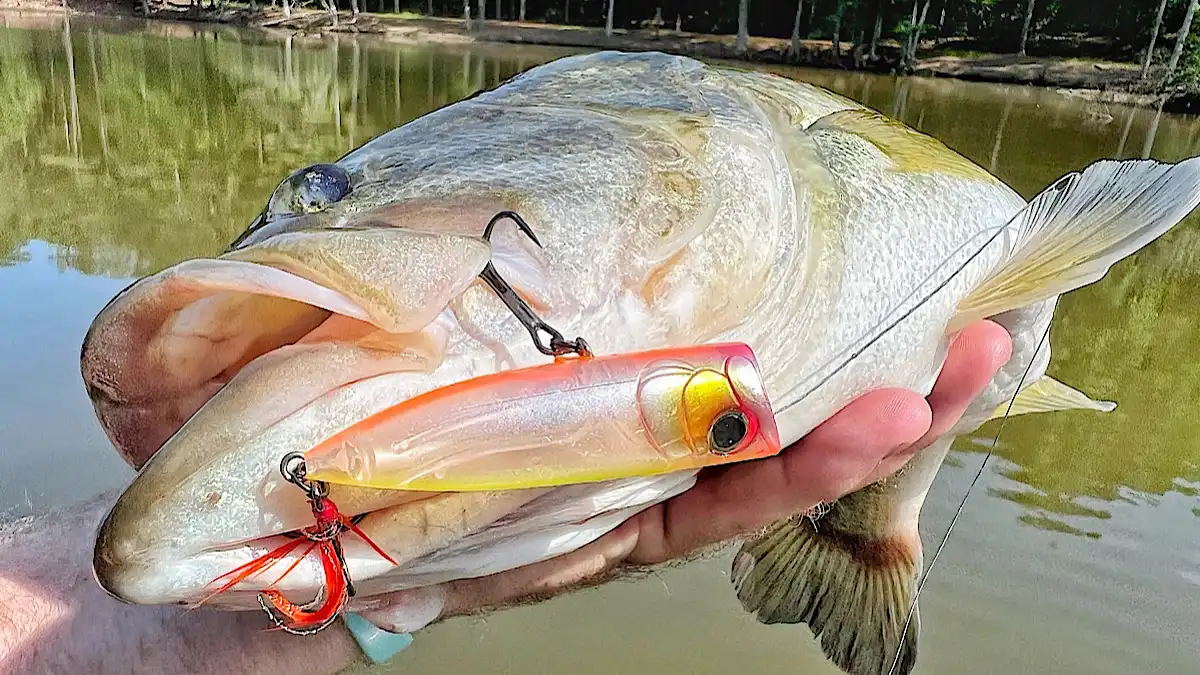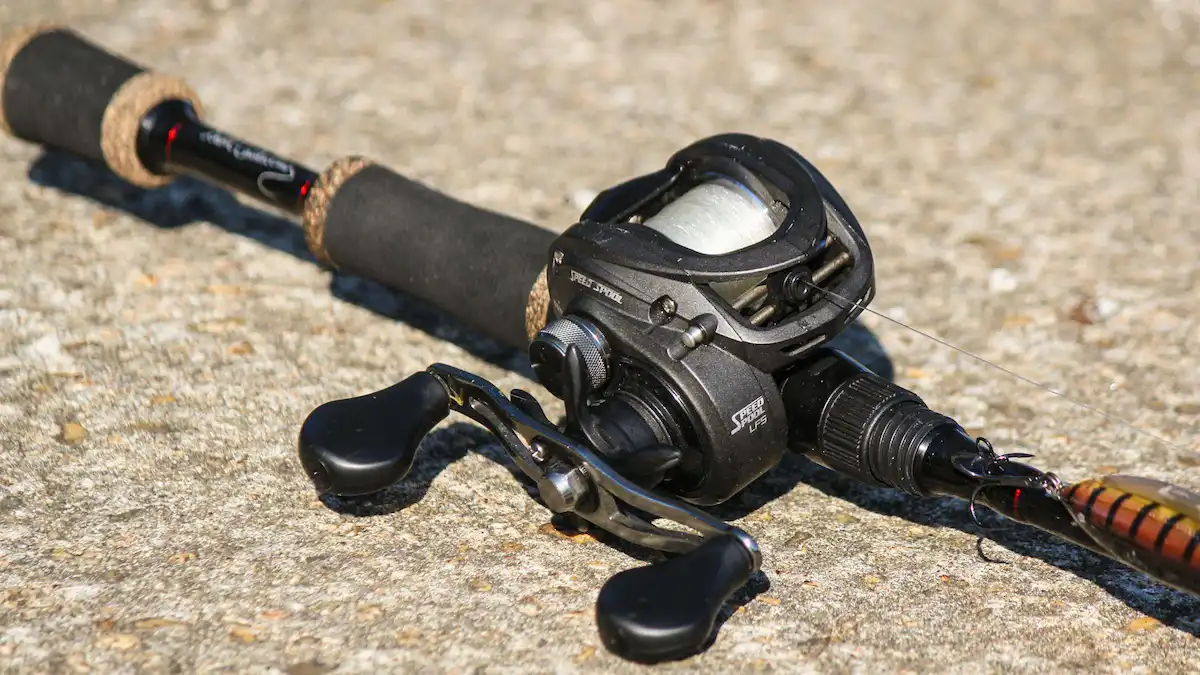Bass fishing is all about answering three simple, but often perplexing and frustrating, questions.
- What to throw
- When to throw it
- Where to throw it
Taking the guesswork out of fishing is the key to success. Look at the meteoric rise in the popularity of forward facing sonar for instance. This technology has become extremely popular in recent years for one simple reason; it answers one of these questions better than anything else ever has before: “Where do I throw?”
Today, we’re aiming to take a little more of the guesswork out of fishing for you. This conversation has more to do with the “what to throw” question. When talking about the gear you need for fishing, there are some areas where it benefits an angler to explore a bit with soft plastic baits, hard lures and rods for example. Then there are other areas where you’re better off remaining consistent with your gear selection, like with lines, hooks and reels. Let’s dive deeper into this conversation.
AREAS TO REMAIN CONSISTENT
- Line
- Hooks
- Reels
AREAS TO EXPLORE
- Rods
- Soft plastics
- Skirted baits
- Hard lures
AREAS TO REMAIN CONSISTENT: LINE
Confidence is another critical component to finding success on the water. Being confident in the fishing line you use will lead to surer hooksets and more adequate pressure when fighting a fish in because you know that you can count on your line not to break.
The way line that comes off a reel varies from brand to brand, and even from one pound test to another within the same brand. This means that when you’re skipping a bait for instance, it benefits you to use the same 17-pound test fluorocarbon every time the cover will allow for it, as opposed to swapping back and forth from 15-pound test to 17-pound test to 20-pound test each trip. You especially don’t want to jump around from brand to brand.
I test fishing lines for a living. While many are high quality, no two are created equal. Each line has a slightly different stretch, the knots cinch down differently and the memory of the lines are not equal. Some braids hold their color longer and don’t fray as easily. Some fluoros are more abrasion resistant. The list goes on.
The point is, once you find a fishing line that you like (that you have confidence in the strength of and that you grow familiar with using), you’re better off sticking with that line than you are jumping around different brands. For me, for instance, I have a ton of confidence in the Seaguar InvizX fluoro and Sufix 832 braid.
That’s not to say there aren’t other good lines out there, but these are the two that I landed on years ago when sampling different lines. They have held up to many tests and I am very familiar with how they behave. Additionally, I make it a point to use very few sizes. I use primarily 15- and 17-pound test InvizX for fluoro and 40-pound Sufix for almost every braid application, moving up to 65 for punching.
HOOKS
Hooks are another highly critical piece to the puzzle. There’s some debate over whether the line or the hook is the most critical element between the angler and the fish. I’d say it’s a tossup between the two, and they are equally important. Hooks are another area where you’re better off finding a specific hook for each application that you can trust, and then sticking with it.
This takes some trial and error of course. You kind of have to use several hooks to figure out which ones will fail and which will perform the best with the given task. You’re looking for a few things with hooks: sharpness, strength and how the hook pairs up with the bait. Strength and sharpness are must haves for obvious reasons. How a given hook pairs with a given bait can be a little more nuanced.
Here’s an example: you have thicker soft plastics that you want to rig weedless. A traditional offset worm hook will not perform as well with a meaty bait as an EWG (extra wide gap) hook will. The wider gap has more room for the thicker bait to move out of the way of the point.
The debate between short shank treble hooks and long shank ones is another good illustration of this. Short shank EWG treble hooks are better for lipless cranks for instance, since a bass will often inhale the whole bait. However for topwaters, round bend, long shank trebles create more opportunity for a swiping bass to hookup.
Again, within this broader discussion of what style and size hook to use, there’s the decision to be made between brands. I have found two hooks that I use a ton in all my time testing products and fishing competitively: a 4/0 VMC Heavy Duty Flipping Hook and a 4/0 Gamakatsu SuperLine EWG Hook. When punching and flipping with money on the line, I use the VMC hook every time.
Perhaps there’s a better hook out there, but this one has held up for me time and time again, so why bother looking? The same can be said for the Gamakatsu EWG. I use that hook with toads, Senkos and anything I want to Texas rig that has a little meat to it. It’s a phenomenal hook that is sharp, doesn’t bend and gets the job done.
REELS
The reel department is another of the key areas where you want to remain consistent with your gear selections. As stated previously (and as is obvious to anyone who has read much of my work here at Wired2Fish), I have the pleasure and privilege of reviewing fishing gear for a living. In this role, I test a lot of reels. There are a plethora of quality reels out there now, but I’ve become most familiar with the ones made by Lew’s.
I’ve used Lew’s baitcasting reels for over a decade, and almost exclusively during my time fishing the semi-pro circuits after college. I became intimately in tune with how they work. In the last few years, I’ve tested a lot of great gear from different companies. However, if someone was going to hand me a reel in a box and offer me a thousand dollars to spool it up, set it and hit a coffee can at 50 feet on my first cast, I’d take the $100 Lew’s LFS over a $500 reel and take my chances.
This is not to say there aren’t better reels out there. The LFS isn’t even the “best” reel that Lew’s offers (I’m currently testing the new HyperMag that retails for $349, and I am smitten). The point is that I am familiar with this reel and thus more capable with it. I have owned two or three dozen of the LFS reels in the past decade.
I could take it out of the box, set the brake to 4 and turn the spool tension knob forward until I felt the right amount of resistance, then tie on a 1/2-ounce jig and hit that can pretty dang quickly. All because I know how to get that particular reel to do what I want it to do before I even get it out of the box.
Familiarity with how the brakes, the spool tension knob and the drag system of a reel operate and perform is so important. While many of these systems are the same throughout most of the various brands’ different reel models, very few of them translate directly from one brand to another.
It even comes down to how the handle of a reel feels in-between your fingertip and your thumb. There’s a big difference between the flat paddles of a Lew’s handle and the more squared-off, thicker grips on an Abu Garcia reel. One isn’t better or worse, but when a big one blows up on a frog, you’re going to want your muscle memory to kick in and grab for what it’s used to.
AREAS FOR EXPLORATION
We’ve talked at length about the areas where consistency in your gear selection is your best bet. Now, we’ll briefly touch on some areas where you can play around a bit. Bait selection is one of the areas where you’ll definitely want to sample from a variety of different brands.
You’ll still find confidence baits in time, like with a hollow body frog lures for instance. Once you get to where you have a lot of confidence in skipping a Strike King KVD Sexy Frog or in the hook-up ratio of a SPRO Bronzeye Popping Frog 60, as examples, you won’t really have a reason to throw a bunch of other frogs.
Getting to play around and test out the latest hard baits, spinnerbaits, jigs and soft plastics is a large part of what makes fishing fun and exciting. You’ll find new favorites time and time again if you let yourself explore in this arena.
Rods, unlike reels, are another good area to mix and match between different brands. There is something to be said for remaining consistent across a particular brand with your rod selections, but I’ve found this less critical than with reels.
There are some specific rod models that I like more from specific brands, like the Fitzgerald Fishing 7’8” Heavy Big Jig/Mat Flippin’ rod for instance. I’ve also found a few of the mid-range baitcasting rods from Ark Fishing that I like a lot in the Cobb Series and Tharp Series. I’ve been testing some Lew’s, St Croix and 13 Fishing rods that I like a lot lately as well.
What I’ve found with rods is that I don’t mind jumping from brand to brand to find a specific rod for a specific application, but there are a few elements that I like a rod to have across any brand. I really like split grips for example, as opposed to a full cork handle. It doesn’t really matter as much to me if the grips are made of EVA foam or cork, but I like the split grip part of it. I’m kind of a Goldilocks on the guides, I don’t like them too small or too big, but in the middle is just right. Almost all of my favorite rods, despite the brand, all have split grips and mid-range guides.
IN CONCLUSION
Remember that there are times when it’s okay to explore and play around when selecting your fishing gear and then there are times when it’s better off remaining consistent. Hooks, lines and reels are all areas where I personally believe you don’t want to have 10 or 12 options in each rotation. Find two or three hooks you like, a trustworthy fluoro, a reliable braid and then a predictable reel and you’ll be set up for success.
Play around with the bait selection and you’ll find in doing so that you develop a lot of confidence in a few favorites. Fight the urge to not let that confidence make you complacent. Stay curious and always be willing to give a new bait or technique a chance to prove itself. Remember with rods, you’ll develop preferences over time based on what you like about certain rods, but it’s okay to create a mosaic from a few different brands. I believe if you implement this advice, you’ll develop a lot of confidence in your bass fishing arsenal.

















